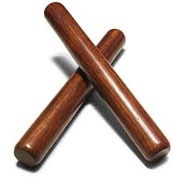 by Chaz Bufe, author of An Understandable Guide to Music Theory.
by Chaz Bufe, author of An Understandable Guide to Music Theory.
The word claves refers to two things (in English): the rhythms underlying Afro-Cuban music (especially the two-bar “son” or 3-2 clave pattern: 1, and of 2, 4; 2, 3 — a long pre-existing, basic pattern which Bo Diddley somehow had the balls to relabel as “the Bo Diddley beat”); and the approximately 9″-long (23 cm) hardwood sticks (usually mahogany or, here in the Southwest, ironwood), one slightly smaller in diameter than the other.
 Claves are almost always misplayed on rock recordings. (They’re normally played correctly on Afro-Cuban and Latin Jazz recordings.) Why? Rock musicians simply don’t know how to play them properly, and so get the dreary “clunk” sound — exemplified on the Who’s “Magic Bus” — rather than the much brighter “clink” sound when properly played. (The “clunk” is produced by wrapping your hands around the claves and banging them together wherever’s convenient.)
Claves are almost always misplayed on rock recordings. (They’re normally played correctly on Afro-Cuban and Latin Jazz recordings.) Why? Rock musicians simply don’t know how to play them properly, and so get the dreary “clunk” sound — exemplified on the Who’s “Magic Bus” — rather than the much brighter “clink” sound when properly played. (The “clunk” is produced by wrapping your hands around the claves and banging them together wherever’s convenient.)
So, how do you play them correctly? There are three things to keep in mind:
- Do not wrap your hands around them. Rather, cup your hands, grasp both claves about 60% of the way up with your thumb and index finger, and rest the butt on the heel of your hand. Again, do not grasp them.
- If you’re right-handed, hold the smaller (skinnier) of the two claves in your right hand — it’ll produce a brighter sound when you strike it against the other. (If you’re left-handed reverse this: the thing to keep in mind is that the smaller clave is the striking clave.)
- And strike the clave in your left hand about an inch or a hair over (about 3 cm) from the end.
Do this, and you’ll get a great sound — better (at least in this regard) — than The Who. It’ll take a bit of practice, but you’ll get there quickly.